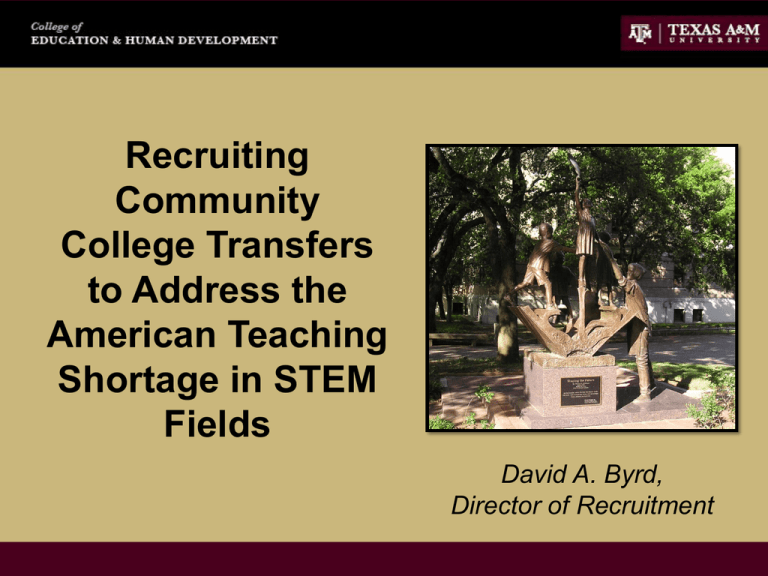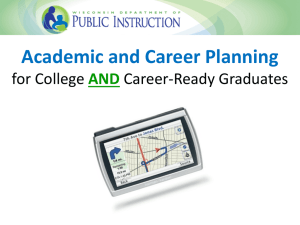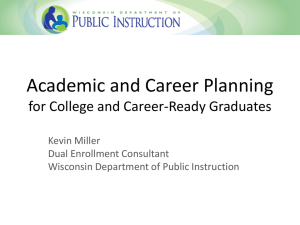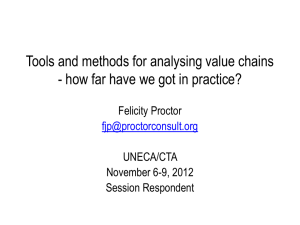Recruiting Community College Transfers to Address the American
advertisement

Recruiting Community College Transfers to Address the American Teaching Shortage in STEM Fields David A. Byrd, Director of Recruitment Agenda • Review of Literature • Statistical Analysis of Transfer Performance • Demonstrated Recruitment Efforts • Case Study for Collaboration “If the United States is to maintain a competitive edge in the present era of the ‘global economy,’ an educated workforce is more important than at any other time in our history” (Hagedorn & Tierney, 2002, p. 2). “… Participation and degree attainment rates have leveled off and are showing sighs of decline – seemingly more than just a bump or short-term market correction … we find these disparities are growing” (Douglass, 2006, p. 3). In 2004, China had six times the number of college graduates in engineering as the United States” and “India and China produced approximately one million engineering graduates a year, with the U.S. and Europe producing only 170,000 combined” (Douglass, 2006, p. 7). “Of the articles in the world’s top physics journals published in 1983, 61% were authored by scholars in American Universities; in 2003 that proportion dropped to 29%” (p. 7). The truth is, we’re in a crisis now, but it is a crisis that is unfolding very quietly. We’re a bit like a person who is sleeping on an air mattress, and the air is coming out – so slowly you barely feel it, until your head hits the cement. By then it’s really hard to reinflate the mattress” (Friedman, 2007, p. 340). So, what is causing our mattress to deflate? Thomas Friedman’s Dirty Little Secrets: (1) Numbers Gap (2) Education Gap (at Top) (3) Ambition Gap (4) Education Gap (at Bottom) (5) Funding Gap (6) Infrastructure Gap (Friedman, 2007, pp. 337-365) “The United States faces a shortage of 283,000 secondary math and science teachers by 2015” (BHEF, 2006). Physics departments are not actively engaged in recruiting physics teachers, and few have partnerships with schools of education. (Physics Teacher Education Coalition, 2010). 54% of schools surveyed by Ingersoll (2003) reported having vacancies in Math in 2000 and 42% reported having difficulty hiring Science teachers. Projected Need for Secondary Math Teachers in Texas 12,000 # Teachers 10,000 8,000 6,000 4,000 2,000 0 2004 2005 2006 2007 2008 2009 2010 2011 2012 Supply Source: Dr. Ed Fuller (2009) Demand Projected Need for Secondary Science Teachers in Texas 12,000 # Teachers 10,000 8,000 6,000 4,000 2,000 0 2004 2005 2006 2007 2008 2009 2010 2011 2012 Supply Source: Dr. Ed Fuller (2009) Demand Salary for Teachers Compared to Other STEM Fields $100,000 All Secondary STEM Teachers (Total Salary) $90,000 $80,000 Computer and Mathematical Occupations Avg Salary $70,000 $60,000 $50,000 Architecture and Engineering Occupations $40,000 $30,000 Engineering Occupations Only $20,000 $10,000 $0 2000 2007 Year Source: Dr. Ed Fuller (2009) Number of Middle-School Teachers Assigned Out-of-Field 3000 2500 2000 1500 1000 500 0 1999 2000 2001 2002 2003 2004 2005 2006 2007 2008 Mathematics Source: Dr. Ed Fuller (2009) Science Number of High School Teachers Assigned Out-of-Field 3000 2500 2000 1500 1000 500 0 1999 2000 2001 2002 2003 2004 2005 2006 2007 2008 Mathematics Source: Dr. Ed Fuller (2009) Science Percentage of Secondary Math Teachers Assigned Out-of-Field by Poverty Level 50% 40% 30% 20% 10% 0% 2003 2004 2005 Low-Poverty Source: Dr. Ed Fuller (2009) 2006 2007 High-Poverty 2008 Percentage of Secondary Science Teachers Assigned Out-of-Field by Poverty Level 50% 40% 30% 20% 10% 0% 2003 2004 2005 Low-Poverty Source: Dr. Ed Fuller (2009) 2006 2007 High-Poverty 2008 100% 90% 80% 70% 60% 50% 40% 30% 20% 10% 0% Permit Cert by Exam Out-of-State Alternative Post Bacc Traditional 19 95 19 96 19 97 19 98 19 99 20 00 20 01 20 02 20 03 20 04 20 05 20 06 20 07 % Teachers Certified Production of Secondary Science Teachers by Route Spring of Academic Year Source: Dr. Ed Fuller (2009) Production of Math and Science Teachers by Route Program Type and Certification Route Univ Traditional Mathematics 2002 2008 Science CHG 34.4% 21.7% -12.7 2002 2008 CHG 19.1% 9.9% -9.2 Univ Post-Bacc 1.8% 2.7% 0.9 2.6% 3.9% 1.3 Univ ACP 7.2% 6.4% -0.8 10.9% 8.3% -2.6 District ACP 2.7% 3.1% 0.4 2.9% 4.1% 1.2 District ACP Permit 3.2% 0.1% -3.1 3.0% 0.2% -2.8 Region ESC ACP 7.1% 5.6% -1.5 8.1% 10.1% 2.0 Comm College ACP 2.8% 2.2% -0.5 1.7% 3.2% 1.5 Private ACP 1.9% 23.1% 21.2 3.3% 30.4% 27.1 16.7% 12.7% -4.0 18.6% 13.9% -4.7 6.3% 21.3% 15.0 12.7% 15.2% 2.4 1.1% -14.8 17.1% 0.8% -16.2 Out-of-State Cert-by-Exam Permit 15.9% Source: Dr. Ed Fuller (2009) First-time Pass Rate of the TExES Certification Exam in 2008 FIRST-TIME TEST-TAKERS Prep Program Type Mathematics MS HS Science MS HS University 74.8% 63.9% 63.1% 50.3% District ACP 70.8% 62.4% 65.3% 51.5% Region ESC ACP 74.0% 62.6% 66.4% 57.0% Comm College ACP 69.5% 62.1% 63.6% 53.1% Private ACP 59.7% 53.7% 54.3% 42.1% Total 70.2% 61.1% 61.5% 49.1% Source: Dr. Ed Fuller (2009) Last-time Pass Rate of the TExES Certification Exam in 2008 LAST-TIME TEST-TAKERS Prep Program Type Mathematics MS HS Science MS HS University 89.8% 83.4% 81.7% 69.6% District ACP 87.6% 78.9% 81.7% 82.9% Region ESC ACP 88.3% 82.1% 87.1% 77.9% Comm College ACP 84.4% 79.2% 81.5% 72.8% Private ACP 71.5% 69.1% 68.1% 59.9% Total 84.4% 79.2% 78.9% 68.8% Source: Dr. Ed Fuller (2009) Three-year Attrition Rates for Teachers by Program and Route Univ Traditional Science Univ Post-Bacc Math Univ ACP District ACP Region ESC ACP Comm College ACP Private ACP Permit Out-of-State Cert-by-Exam 0.0 Source: Dr. Ed Fuller (2009) 10.0 20.0 30.0 40.0 50.0 Rising Above the Gathering Storm (2007) • 2/3 of America’s K-12 teachers are expected to retire in the next decade – requiring schools to fill between 1.7 million and 2.7 million vacancies. • 200,000 new Secondary Math and Secondary Science teachers will need to be hired in the next decade. • Recommends the hiring of 10,000 new teachers annually to educate 10 million minds. • Improve the skills of 250,000 teachers through continuing education programs. How Can Community Colleges Solve the Problem? • America faces a critical shortage of teachers of color willing to work in our most challenging schools (Lewis, et al., 2008). • Community college enrollments continue to rise – especially for college students of color (Cohen & Brawer, 2008). • Within the CEHD at Texas A&M, transfer students were found to not suffer transfer shock and were more likely to complete the undergraduate degree on time (CEHD, 2010). Statistical Analysis of Transfers in the TAMU Teacher Education Program 2009-2010 Academic Year Transfer Cohort GPA Student Type All Students in Cohort Under-Represented Students in Cohort Previous Institution GPA 3.1236 3.1409 TAMU Firstsemester GPA 3.3492 3.32 2009-2010 Academic Year Transfer Cohort t Test Analysis Dependent Variables Previous GPA - First-Semester GPA Source: CEHD, 2010 t -4.601 df 156 Texas A&M University • First Public University in Texas (1876) • Tier I Research Institution with an enrollment of ~49,000 • Top 10 endowment valued at over $5 billion • One of the highest retention rates for under-represented populations in Texas and US College of Education & Human Development • Recently Celebrated its 40th Anniversary • Fifth largest undergraduate program at Texas A&M (n=3,822) • US News (2009) ranked CEHD 47th among all professional schools of education and 34th among all public institutions • Largest producer of teachers for the high need fields of Math, Science, and Bilingual Education in Texas Summer Transfer Workshops • Provides information sessions for community college students to receive information necessary to successfully matriculate to the four-year university. • Includes Admissions, Financial Aid, and Academic Advising. • Numbers are restricted to no more than 20 students per workshop. CEHD Ambassador Program • Current students serve as ambassadors. • Students visit area community colleges to represent teaching as a career. • Ambassadors host students who visit campus. • Ambassadors assist by making matriculation calls to welcome new admits.. Quantitative Tracking and Database Management • Prospective Student Data Cards are collected at all recruitment events and from all campus visitors. • Identify programs that were successful and pipeline schools to maximize resources. • Share data with offices on campus to maximize efforts. Partner with School Organizations • Visit with Future Teacher Classes and Organizations on community college campuses. • Organizations provide logistical opportunities to speak to groups when visiting campuses and provide identification opportunities of talented students. Web-based Recruitment http://educate.tamu.edu • During the 2009-2010 academic year, 8,774 (70.06% new visits) people had viewed the http://educate.tamu.edu website • Use Google Analytics to analyze web performance. Transfer Articulation Program (TAP) • Signed Articulation Agreements with community college in large urban environments. • Formulated by Dr. Robert Gates in 2005 when he was President of Texas A&M University. • Guarantees automatic transfer admission for students who complete prescribed courses with a minimum 3.0 GPA. Campus Visit Programs • Community College classes and organizations were hosted on campus throughout the year. • Each visit included interactive programs on teacher education, admissions and financial aid presentations, a campus tour, and lunch with current CEHD students • Between 5-600 students visit the college through these programs annually. aggieTEACH Program • Collaborative effort between the College of Science and College of Education & Human Development to recruit and prepare undergraduate students for Secondary Math or Science teaching. • Scholarships provided through the Sid Richardson Foundation, the National Science Foundation, and the Robert Noyce Foundation. aggieTEACH Testimonials "TEFB 201 helped me realize how much I wanted to be a teacher. I was getting my certification more as a back up. After going through that class and some of my other education classes, I realized I had a passion for teaching and decided to make it my career.” - Melissa Matula, aggieTEACH student "I had an interview with Madison High School in San Antonio and they literally chased me out into the parking lot to offer me a job after the interview. It was my top choice of where I wanted to be and I am so excited. I'm going to be teaching Biology … It is going to be amazing!” - Janeen Kellogg, aggieTEACH student Notable Accomplishments • Recognized by the Texas Education Agency as the only university to increase production of Math, Science, Special Education, and Bilingual Education graduates over a five year period in 2008. • Grown to become the largest producer of Math, Science, and Bilingual Education teachers in Texas. • 98% first-time pass rate of state certification exam. • 84% retention rate of teachers five years after graduation. • 92% five-year retention rate for teachers prepared to work in “urban” schools. Thank you for attending. Questions? Comments? Concerns? References Business Higher Education Forum. (2006). BHEF 2006 issue brief. Retrieved on July 19, 2010 from: http://www.bhef.com/publications/documents/brief3_s06.pdf CEHD. (2010). Transfer Students GPR Comparison 2009-2010. College Station, TX: Texas A&M University, College of Education and Human Development. Cohen, A. M., & Brawer, F. B. (2008). The American community college (5th ed.). San Francisco: Jossey-Bass. Committee on Prospering in the Global Economy of the 21st Century. (2005, October). Rising above the gathering storm: Energizing and employing America for a brighter economic future (ISBN: 0-309-65442-4). Washington, DC: The National Academies Press. Douglass, J. A. (2006). The waning of America’s higher education advantage: International competitors are no longer number two and have big plans in the global economy. Research & Occasional Paper Series, University of California Berkeley, 1-22. Friedman, T. L. (2007). The world is flat: A brief history of the twenty-first century. New York: Picador/Farrar, Straus and Giroux. Fuller, E. (2009, February). Secondary mathematics and science teachers in Texas: Supply, demand, and quality. Presentation form the University Council for Educational Administration. Austin, TX: The University of Texas at Austin. Hagedorn, L. S. & Tierney, W. G. (2002). Introduction: Cultural capital and the struggle for educational equity. In L. S. Hagedorn & W. G. Tierney (Eds.), Increasing Access to College: Extending Possibilities for All Students (pp. 1-8). Albany, NY: State University of New York Press. Ingersoll, R. M. (2003, September). Is there really a teacher shortage? Seattle, WA: Center for the Study of Teaching and Policy. Physics Teacher Education Coalition. (2010, February). National task force on teacher education in physics: Report synopsis. Retrieved on July 19, 2010 from: http://www.compadre.org/ptec/webdocs/TaskForce.cfm Snyder, M. (2010). The middle class in America is radically shrinking. Retrieved on July 26, 2010 from: http://finance.yahoo.com/tech-ticker/the-u.s.-middle-class-is-being-wiped-out-here%27s-the-stats-to-prove-it520657.html?tickers=^DJI,^GSPC,SPY,MCD,WMT,XRT,DIA











